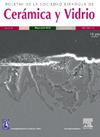Adsorption of natural dye phycocyanin by means of Laponite®: Synthesis and characterization of the hybrid obtained
IF 2.7
4区 材料科学
Q1 MATERIALS SCIENCE, CERAMICS
Boletin de la Sociedad Espanola de Ceramica y Vidrio
Pub Date : 2025-03-01
DOI:10.1016/j.bsecv.2024.09.003
引用次数: 0
Abstract
This work addresses the use of Laponite® clay in various applications, focusing on its adsorption capacity and improvement of properties in water-based products. It describes the synthesis of Laponite® hybrids with the pigmented cyanobacterium phycocyanin (PC) to evaluate the adsorption capacity of the dye. This research addresses the importance of Laponite® clay in improving rheological properties of water-based products due to its ability to interact with components in aqueous solutions. Laponite® can be effectively dispersed in water, enhancing the dispersion of other elements in solution and preventing aggregation of solids. The structure and properties of synthetic Laponite® are described, highlighting its use in the textile industry as an additive for pigments and the formation of gels. Experimentally, Laponite® is used to adsorb phycocyanin, a cyanobacterial pigment, with the aim of achieving maximum adsorption. A design of experiments with different experimental conditions, including pH, addition of silane and surfactant, is used. A detailed analysis of the characterization of the resulting hybrids is presented, including colour, total solar reflectance (TSR), thermal analysis (TGA), EDS, FTIR and X-ray diffraction (XRD) measurements. The results show successful adsorption of the pigment in all experiments, with adsorption percentages above 97%. The colour of the hybrids is evaluated and the total solar reflectance is analyzed, highlighting their importance in applications such as coatings and printed textiles. Infrared spectroscopy and X-ray diffraction are used to study the structural properties of the hybrids. For future work, it is intended to be able to apply the hybrids obtained on an industrial scale in the colouring of textiles and plastic polymers.
利用 Laponite® 吸附天然染料藻蓝蛋白:所获混合物的合成与表征
这项工作解决了Laponite®粘土在各种应用中的使用,重点是其吸附能力和水性产品性能的改进。它描述了与色素蓝藻蓝蛋白(PC)合成的Laponite®杂交体,以评估染料的吸附能力。本研究解决了Laponite®粘土在改善水性产品流变特性方面的重要性,因为它能够与水溶液中的组分相互作用。拉脱石®可以有效地分散在水中,增强溶液中其他元素的分散,防止固体的聚集。介绍了合成拉脱石®的结构和性能,重点介绍了它在纺织工业中作为颜料添加剂和凝胶形成的用途。实验中,Laponite®被用来吸附藻蓝蛋白,一种蓝藻色素,目的是实现最大的吸附。设计了不同的实验条件,包括pH、硅烷的加入和表面活性剂。对所得到的杂化物进行了详细的表征分析,包括颜色、太阳总反射率(TSR)、热分析(TGA)、EDS、FTIR和x射线衍射(XRD)测量。结果表明,所有实验均成功吸附了色素,吸附率均在97%以上。对混合材料的颜色进行了评估,并对太阳总反射率进行了分析,强调了它们在涂料和印花纺织品等应用中的重要性。利用红外光谱和x射线衍射对其结构特性进行了研究。对于未来的工作,它的目的是能够在工业规模上应用于纺织品和塑料聚合物的着色。
本文章由计算机程序翻译,如有差异,请以英文原文为准。
求助全文
约1分钟内获得全文
求助全文
来源期刊

Boletin de la Sociedad Espanola de Ceramica y Vidrio
工程技术-材料科学:硅酸盐
CiteScore
5.50
自引率
2.90%
发文量
72
审稿时长
103 days
期刊介绍:
The Journal of the Spanish Ceramic and Glass Society publishes scientific articles and communications describing original research and reviews relating to ceramic materials and glasses. The main interests are on novel generic science and technology establishing the relationships between synthesis, processing microstructure and properties of materials. Papers may deal with ceramics and glasses included in any of the conventional categories: structural, functional, traditional, composites and cultural heritage. The main objective of the Journal of the Spanish Ceramic and Glass Society is to sustain a high standard research quality by means of appropriate reviewing procedures.
 求助内容:
求助内容: 应助结果提醒方式:
应助结果提醒方式:


